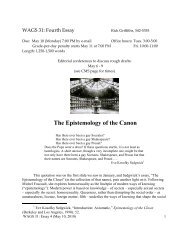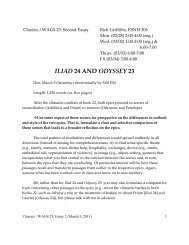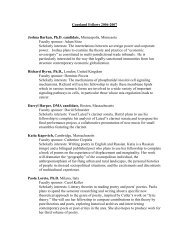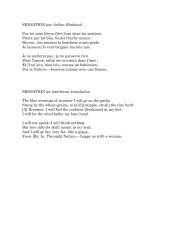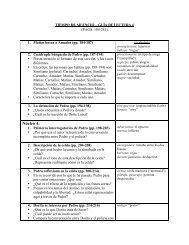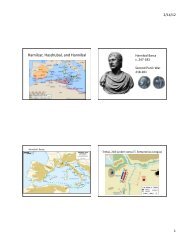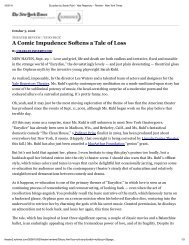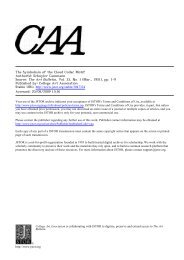Finding Their Voices - Amherst College
Finding Their Voices - Amherst College
Finding Their Voices - Amherst College
You also want an ePaper? Increase the reach of your titles
YUMPU automatically turns print PDFs into web optimized ePapers that Google loves.
many, it came to cause a variety of new problems, and eventually developed many of the<br />
same issues it was designed to fix. Ministers used a limited number of tunes in their<br />
sermons (often only up to three or four) and, as time went on, they each organically<br />
developed their own variants. In addition, the minister often began lines without regard<br />
to where the range of the melody lay in the voice, making it difficult for the congregation<br />
to accurately repeat him.<br />
Some believed that this mode of singing was ruining songs in worship.<br />
According to Thomas Walters, an early eighteenth-century music instructor, psalm tunes<br />
had become “miserably tortured, and twisted, and quavered, in some Churches, into a<br />
horrid Medley of confused and disorderly Noises,” the “doubtful Conveyance of Oral<br />
Tradition” had left the music “to the Mercy of every unskillful Throat to chop and alter,<br />
twist and change, according to their infinitely divers and no less odd Humours and<br />
Fancies.” 180 Very often each member of the congregation sang slightly different versions<br />
of the same tune, resulting in “something so hideous and disorderly, as it is beyond<br />
Expression bad.” Conventional performance practice seems to have taken up much time<br />
in “shaking out Turns and Quavers” in a style unique to each singer, resulting in an<br />
overall impression that “Five Hundred different tunes roared out at the same time, whose<br />
perpetual interferings with one another, perplexed Jars, and unmeasured Periods, would<br />
make a Man wonder at the false Pleasure, which they conceive in that which good Judges<br />
of Musick and Sounds, cannot bear to hear.”<br />
!!!!!!!!!!!!!!!!!!!!!!!!!!!!!!!!!!!!!!!!!!!!!!!!!!!!!!!!<br />
180 Thomas Walters, Grounds and Rules of Musick Explained; or, an Introduction to the Art of Singing by<br />
Note (1721). A “Recommendatory Preface” to the work was signed by fifteen prominent American<br />
ministers, including two of John Cotton’s sons, Cotton Mather and Increase Mather. The following quotes<br />
are from the same source.<br />
! 124!




